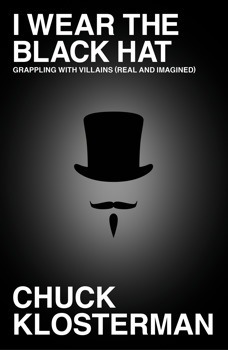I Wear the Black Hat Summary
7 min read ⌚
 Grappling with Villains (Real and Imagined)
Grappling with Villains (Real and Imagined)
Villainy – just like beauty – is in the eye of the beholder. Human laws are not perfect and, sometimes, transgressing them may seem more just than obeying them.
Chuck Klosterman is here with a collection of twelve essays analyzing the paradox. And we have the “I Wear the Black Hat” summary.
Who Should Read “I Wear the Black Hat”? And Why?
The most straightforward answer to this question is probably – people who are interested in comical writing and satirical humor. Because, even though the book is provocative, you’ll appreciate it more if you like the style.
Curiosity about popular culture, sports and music is a plus. And an interest in villainy is a must.
About Chuck Klosterman
Chuck Klosterman is an American essayist and author who mainly writes on topics related to American popular culture.
is an American essayist and author who mainly writes on topics related to American popular culture.
A regular columnist for both “Esquire” and “The New York Times” magazine in the past, he has also written for “The Washington Post,” “The Guardian,” “Spin,” and “ESPN.com.”
He is the author of two novels, few essay collections and five widely read works of non-fiction. “Sex, Drugs, and Cocoa Puffs” and “Killing Yourself to Live: 85% of a True Story” are probably his most famous books.
“I Wear the Black Hat Summary”
Sometimes, we tend to forget that the easiest questions might be the most difficult ones to answer.
For example, most people won’t even hesitate for a second before answering a question such as what it means to be a villain.
After all, we’ve watched so many movies that our mind is capable of profiling hundreds of villains in a second!
Of course, the villain is the bad guy, the antagonist, the one who tries to harm the people or the one who tries to show the hero that most people are bad.
The villain is the one who has a wicked mind, the one who transgresses the law at will, the one who hurts with no reason, who, to quote Mr. Johnny Cash, would shoot a man just to watch him die.
And you know what?
You’re probably right!
Few can argue with that kind of logic because a villain is sometimes some or all of those things. But those are the easy cases. The more difficult ones are the ones you’ll never consider.
Because, unlike movies, life is a misty territory, an area where the line between good and bad is blurred to the point of being unrecognizable.
Don’t believe us?
Then “I Wear the Black Hat” is the right book for you!
It’s a collection of 12 essays in which Chuck Klosterman examines the nature of villainy by closely analyzing famous examples from politics, rock music, sports, and popular culture.
Its premise?
That “the villain is the person who knows the most but cares the least.”
Now, that’s an interesting definition, you may say, but what does it actually mean?
Socrates’ worst nightmare if you want a blatantly honest response!
Because, you see, Socrates believed that people are bad because they don’t know what is good. He hoped that once they learn the differences, it would be impossible for them to act in an evil manner.
Unfortunately, Klosterman says that that’s precisely when an inconspicuous scoundrel becomes an antihero and a villain.
It’s true that you’re not doing something which most people would consider bad if it is known that you don’t know the consequences of your action. Just take children for example! But you do something abhorrently evil and immoral if you do know what it would cause and still decide to do it.
That’s why, for example, most people won’t remember George W. Bush as the bad guy. Even though he is almost unanimously considered one of the worst Presidents in U. S. history, most people also think that he was one of… well, the least intelligent.
No, this cannot be the face of evil!
Dick Cheney, on the other hand – the most powerful Vice President in U. S. history – was seen as a manipulating mastermind ever since he got the position. It was evident that he knew what he was doing; as much as it was apparent that he cared the least about doing it.
But, there’s a catch!
As is obvious by now, you must know a lot about the person in question – if you want to see whether he’s a villain or not. Otherwise, how would you know if he cares and if he knows what he’s actually doing?
And Klosterman has an excellent example to prove this.
If, say, someone asks you who was the greatest villain in history, what would you answer?
99 out of 100 people would probably blurt out “Hitler” right away.
Why Hitler?
Mainly because they have a straightforward answer to this follow-up question.
They know about the Holocaust, about the number of Jews exterminated, about – say – the bombing of London. What’s more, they know who the U.S. was in a war against and even such exciting details as, for example, which one was Hitler’s favorite painting or why he was a vegetarian.
Wait – what?
No, I know that he was a vegetarian, you say, but how is this related to the fact that he was a villain?
Interestingly enough, it may be the most important bit. Because the more you know about someone, the more you can relate to him. And, consequently, understand him – and judge him.
Because, you see, Hitler killed twice as fewer Jews as, say, King Leopold did Congolese. But, we bet that you don’t know who King Leopold was, right?
Even worse, you do know who Stalin and Mao were, but, for some reason, you think they were slightly better guys than our least favorite German Adolf.
Why?
Stalin killed at least as many people more than Hitler. As for Mao… believe us, you don’t want to know!
And the only reason why they are less evil than Hitler?
You know less about them. And, paradoxically, you think of them as both less human and less evil. Abstractions can’t be as wicked as wicked people.
Because the former sound as if taken straight out of some story or a myth; and the latter are evidence that evil exists on earth.
And that it lurks around the next corner.
Key Lessons from “I Wear the Black Hat”
1. Imagine the World Behind a Veil of Ignorance
2. In Real Life, Batman Would Be a Villain
3. Plane Hijackers Are Not Always Villains
Imagine the World Behind a Veil of Ignorance
Everyone has its own version of what living in a good world actually means.
Ask a Republican and he will say fewer taxes and freer markets; but ask a Democrat, and he will probably say more taxes and a better redistribution of wealth.
Obviously, different ideologies are based on different moral foundations.
In an attempt to transcend this, John Rawls devised an interesting experiment, asking people to imagine the perfect and most just society from behind a veil of ignorance.
In other words, create a society from scratch, while being aware that after that happens, you’ll enter it as a brand-new person who could be absolutely anyone. You may end up being black or white, homeless or an owner of seven mansions, an immigrant from a war-torn country or an inhabitant of an earthly paradise.
Suddenly, what’s right and what’s wrong doesn’t seem as obvious, does it?
In Real Life, Batman Would Be a Villain
Movies – especially Hollywood blockbusters – are made with the idea of making money. Lots and lots of it.
Now, that means that most of the movies you watch present a simplified version of the world. Producers don’t want you to bother thinking too much. They want to see you rooting for the good guy – so they make it clear straight away who’s who.
However, in real life, the line between good and bad is blurry. For example, a real-life Joker would obviously be a bad guy. But, a real-life Batman as well.
Just think of it – a masked man beating people up!
In fact, you don’t even have to imagine it: read something about Bernhard Goetz and the New York subway shooting of 1984. Goetz was white, and he shot four alleged black muggers in self-defense.
And already it seems that it isn’t straightforward and simple.
Well, in real life – it almost never is.
Plane Hijackers Are Not Always Villains
Which brings us to our next example.
On November 24, 1971, a man – now known by the epithet D. B. Cooper – hijacked an aircraft, extorted about $1,000,000 in today’s money in ransom and parachuted into an unknown direction, never to be seen again.
However, he was also dubbed “a gentleman” by those on the plane.
And we bet you won’t think of him as a villain even when you read the whole story.
But why?
He hijacked a plane and stole some of your money.
As we said, it’s not that simple. If it were, movies like “Ocean’s Eleven” wouldn’t have been possible.
You know, the ones which make you start rooting for the bad guys.
Like this summary? We’d like to invite you to download our free 12 min app, for more amazing summaries and audiobooks.
“I Wear the Black Hat Quotes”
It has always been my belief that people are remembered for the sum of their accomplishments but defined by their singular failure. Share on X We all eventually become whatever we pretend to hate. Share on X Necessity used to be the mother of invention, but then we ran out of things that were necessary. The postmodern mother of invention is desire; we don’t really ‘need’ anything new, so we only create what we want. Share on X First, you must love yourself. And if you do that convincingly enough, others will love you too much. Share on X I care about strangers when they're abstractions, but I feel almost nothing when they're literally in front of me. Share on XOur Critical Review
As a “New York Times” review stated after the book was published, “I Wear the Black Hat” is certainly not Chuck Klosterman’s best book. But, nevertheless, it’s both exciting and thought-provoking. Not to mention witty and funny.
Read it without many expectations. And you’ll enjoy it.
Emir is the Head of Marketing at 12min. In his spare time, he loves to meditate and play soccer.


 Grappling with Villains (Real and Imagined)
Grappling with Villains (Real and Imagined) 




